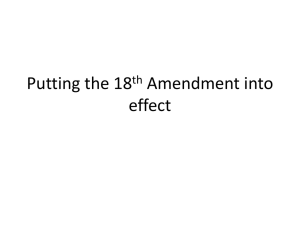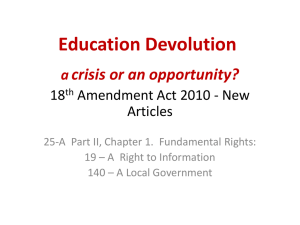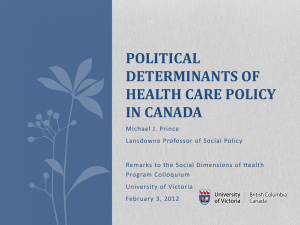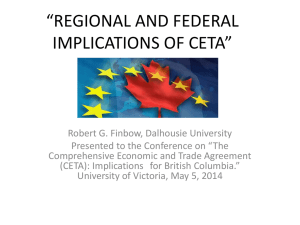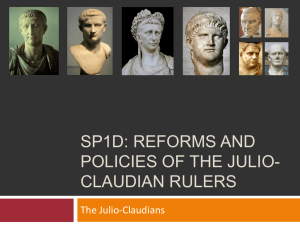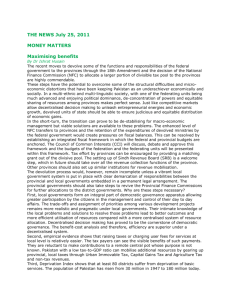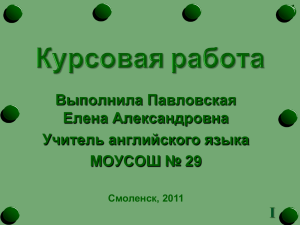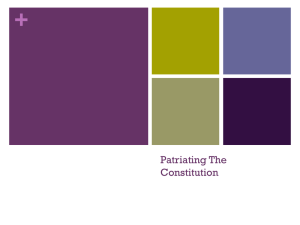zubair - Lahore School of Economics
advertisement
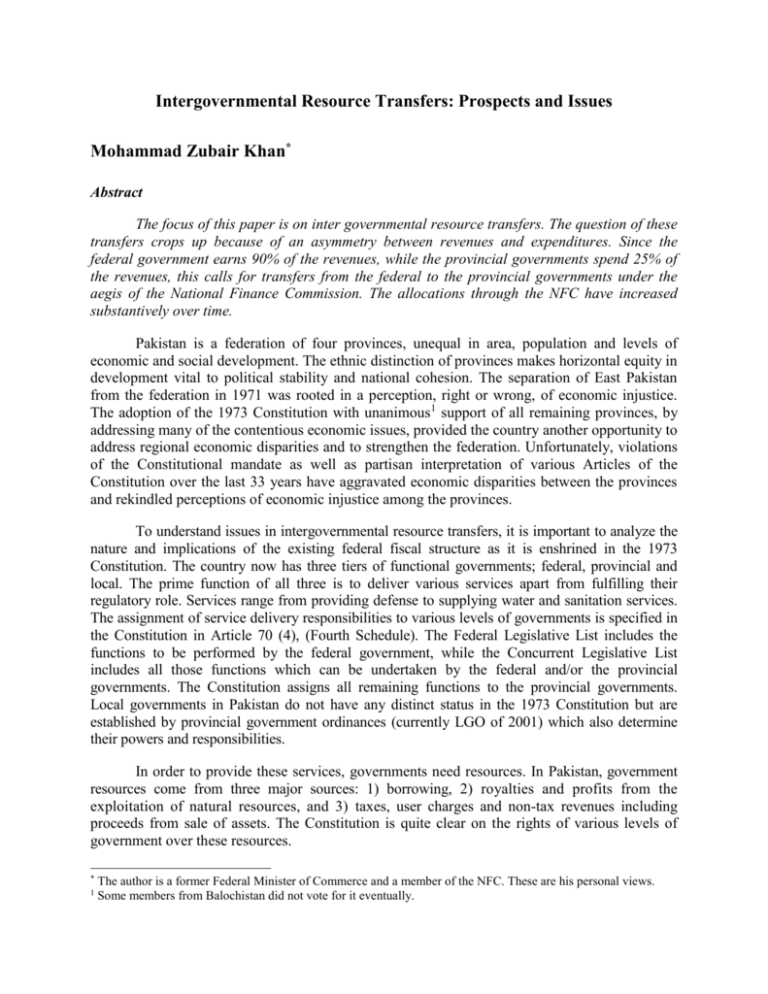
Intergovernmental Resource Transfers: Prospects and Issues Mohammad Zubair Khan* Abstract The focus of this paper is on inter governmental resource transfers. The question of these transfers crops up because of an asymmetry between revenues and expenditures. Since the federal government earns 90% of the revenues, while the provincial governments spend 25% of the revenues, this calls for transfers from the federal to the provincial governments under the aegis of the National Finance Commission. The allocations through the NFC have increased substantively over time. Pakistan is a federation of four provinces, unequal in area, population and levels of economic and social development. The ethnic distinction of provinces makes horizontal equity in development vital to political stability and national cohesion. The separation of East Pakistan from the federation in 1971 was rooted in a perception, right or wrong, of economic injustice. The adoption of the 1973 Constitution with unanimous1 support of all remaining provinces, by addressing many of the contentious economic issues, provided the country another opportunity to address regional economic disparities and to strengthen the federation. Unfortunately, violations of the Constitutional mandate as well as partisan interpretation of various Articles of the Constitution over the last 33 years have aggravated economic disparities between the provinces and rekindled perceptions of economic injustice among the provinces. To understand issues in intergovernmental resource transfers, it is important to analyze the nature and implications of the existing federal fiscal structure as it is enshrined in the 1973 Constitution. The country now has three tiers of functional governments; federal, provincial and local. The prime function of all three is to deliver various services apart from fulfilling their regulatory role. Services range from providing defense to supplying water and sanitation services. The assignment of service delivery responsibilities to various levels of governments is specified in the Constitution in Article 70 (4), (Fourth Schedule). The Federal Legislative List includes the functions to be performed by the federal government, while the Concurrent Legislative List includes all those functions which can be undertaken by the federal and/or the provincial governments. The Constitution assigns all remaining functions to the provincial governments. Local governments in Pakistan do not have any distinct status in the 1973 Constitution but are established by provincial government ordinances (currently LGO of 2001) which also determine their powers and responsibilities. In order to provide these services, governments need resources. In Pakistan, government resources come from three major sources: 1) borrowing, 2) royalties and profits from the exploitation of natural resources, and 3) taxes, user charges and non-tax revenues including proceeds from sale of assets. The Constitution is quite clear on the rights of various levels of government over these resources. * 1 The author is a former Federal Minister of Commerce and a member of the NFC. These are his personal views. Some members from Balochistan did not vote for it eventually. The distribution of powers of taxation between various levels of government is spelt out in the Fourth Schedule of the 1973 Constitution. Following the last NFC award in 1996, the federal government collects all revenues from income taxes, corporation taxes, sales taxes, custom duties and federal excise duties. The provincial governments collect user charges and tax revenues comprising agricultural income tax, provincial excise duty, stamp duty, motor vehicle registration tax, entertainment tax, and various types of ‘cess’. There are few sources of revenue left with the local governments. The broad principles of allocation of royalties and profits from natural resources (applying only to gas and hydroelectric power) are spelt out in Article 161 of the Constitution. According to the latter, the federal excise duty on natural gas at well-head and royalty on gas collected by the Federal Government shall be payable to the Province in which the well-head of gas is situated. In addition, the 1996 NFC Award allocated the net proceeds of the development surcharge of gas to the provinces in which the well-head is situated. Article 161 also allocates net profits from the bulk generation of hydroelectric power to the province where the station is situated. The exercise of borrowing powers by the Federal and Provincial Governments conferred under the Constitution, and which constitutes a major resource, is to be determined by the National Finance Commission. By and large, the distribution of regulatory and service delivery functions and taxation in Pakistan conforms to international best practices and criteria of efficiency, equity and least administrative costs. However, an important implication of the constitutional assignment of taxing powers and expenditure responsibilities in Pakistan is that on the one hand all broad-based and buoyant sources of tax revenue are assigned exclusively to the federal government and the provinces (and local governments) are left with residual taxation authority. On the other hand, the provinces and local governments are entrusted with substantial expenditure responsibilities. As a result public finances in Pakistan are characterized by persistently large vertical fiscal imbalances between the federal and provincial governments. The federal government collects about 93 percent of total revenue collected in Pakistan, while it accounts for only 72 percent of aggregate national expenditure. The provinces, by contrast, collect only 7 percent of total national revenue but account for nearly a quarter of total expenditures. While royalty and profits from the sale of natural resources were meant to remedy, at least to some extent, the deficit of the poorest provinces (which happened to be rich in natural resources), in practice this has not happened due to non-compliance with the Constitution and due to manipulations of the calculations of those transfers. Consequently all provinces have remained in deficit of resources in relation to their expenditure responsibilities. The vertical imbalances in the budgets of the three tiers of government could be rectified by reassigning the taxation authority downward to the provincial and local governments, which could also be supported on grounds of better fiscal accountability and greater autonomy of the provinces, but the 1973 Constitution does not follow that route because it would increase regional economic disparities and erode federal cohesion. The latter because fiscal capacities of the provinces (and also districts) are diverse, devolving taxation authority will result in growing differences in public revenues and service delivery between the provinces (and districts). Alternatively, fiscal imbalances can be remedied by reassigning service delivery responsibilities upwards to the Federal Government and the provinces, (in fact this is what happened in the period prior to 2001), but the impact is well known: poor governance, poor service delivery, etc. The 1973 Constitution instead follows the third alternative response to vertical fiscal imbalances: transfer resources from the federal to the provincial governments (and from the provincial to the local governments in LGO 2001). Equitable transfer mechanisms can address regional resource redistribution objectives and ensure efficient service delivery at the appropriate level of government. This is the route adopted in the 1973 Constitution and LGO 2001. The National Finance Commission (NFC) and Provincial Finance Commissions (PFCs) are entrusted with providing such equitable transfer mechanisms. The last NFC Award was made in 1996 for a period of five years. According to the Award, the Federal share in the net proceeds of the divisible pool was fixed at 62.5% with the remainder 37.5% to be distributed between the four provinces on the basis of population. As a result Punjab received 57.88%, Sindh 23.28%, NWFP 13.54% and Balochistan received 5.30% of the provincial share. Considering their relative backwardness, NWFP and Balochistan received special grants/ subventions, which in 1997/98 were Rs. 3,310/- million and Rs. 4,080/- million respectively, set to increase at 11% annually. The 1996 NFC Award also recommended straight transfers to the provinces in lieu of net profits on account of the generation of hydel power and net proceeds of development surcharges, royalties and excise duties from natural gas and oil. However, controversy prevailed throughout the period over the proper determination of royalties, gas development surcharges and hydel profits paid to NWFP and Balochistan. At the end of the Constitutional period of the five year life of the last NFC award, a new Commission was constituted to reach a consensus on the distribution of resources, but without success. The failure of the National Finance Commission to reach a consensus on the division of resources between the Federal and four provincial governments was the most serious deadlock facing the nation and had the potential to destabilize Pakistan’s federal structure. The deadlock was particularly significant because neither the interim nor the present elected governments were able to resolve it. Disagreements remained over almost all issues before the NFC mainly because constitutional obligations, logic and economic arguments were rejected on the grounds of socalled political compulsions. Since an unwritten tradition of the Commission requires that any change in existing shares of governments be made by consensus, a new agreement eluded the Commission because there was always one government that would not agree with the others on each of the issues before the NFC. For instance: The Federal Government refused to discuss the borrowing powers of the five governments and kept projecting unrealistic declines in its own budget deficits over the next five years to underestimate the resources available to it. The Federal Government also disallowed provincial government repayment or refinancing of existing expensive Cash Development Loans (CDLs) during the period of low interest rates, causing the taxpayers losses of billions of rupees. The Federal Government was alone in refusing to increase the share of the provinces to 50 percent from the previous 44.5 percent. Since the last award, provinces had been starved of resources, resulting in a deterioration of provincial infrastructure, a decline in social service delivery and rapid growth in poverty. The excessive share of the federation was difficult to justify following debt rescheduling by Pakistan’s external creditors which has drastically reduced the debt servicing needs of the federal budget. Instead of passing on the rescheduling benefits to the provinces, the federal government set out to spend billions on high profile mega projects including developing holiday resorts for the rich in Gwadar, while depriving the provinces of much needed funds to invest in infrastructure, improve social services and address poverty which increased to unprecedented levels during the last NFC period. The Federal Government was alone in denying that the share of the provinces needed to be increased substantially and urgently to allow them to transfer adequate funds to local governments whose needs could not be met with the proceeds of 2.5% GST revenues from the federation alone. The previous formula left little money for the provinces to pass on to local governments, which in turn, adversely impacted service delivery and poverty. For instance, currently the Provincial Finance Commission in the NWFP has allocated 60 percent of the provincial divisible resources for the district governments, but this amount is not enough to meet even the salary bill of local governments. As a result, the development needs of 24 district governments (three tiers in each district) are being met out of a paltry Rs. 0.9 billion, which is insufficient. Sindh was alone in arguing that revenue collection should be one of the indicators in the formula dividing resources between the provinces. Sindh’s demand implied that provinces have some claim on federal revenues collected within its provincial boundaries. This is not in accordance with the 1973 Constitution. The Constitution is very clear about the division of taxation powers and has given the federation exclusive right to particular tax bases. No province can lay a claim to federal resources. If revenue collection were used as a basis for dividing resources, provinces which are better off and therefore collect more revenue would get a larger share of the public resources and thus increase the disparities that already exist. And if the revenue collection basis was used within the province as well in the PFC, Karachi and Hyderabad would receive all the provincial resources with little left for rural Sindh- a politically explosive proposal. And in any case, the revenue collection potential of provinces today reflects to a considerable extent the allocation of resources over the last fifty-five years which the two smallest provinces may not consider to have been equitable. Thus revenue collection as one or the only factors in the NFC formula will aggravate disparities and provoke divisive debates about the country’s past development priorities. Sindh was also alone in demanding that revenues from 2.5 percent of GST for local governments be divided according to the collections of Octroi and Zila tax on the eve of the abolition of the tax. The other provinces’ view was that the number of local governments was based on population, hence the latter was a good basis for the division of these resources. The lack of consensus about the NFC was further complicated by the continuing dispute between the provinces and the federal departments over the determination of royalties and surcharges on gas and over calculation of hydel profits. In the case of hydel profits, an explanation exists in the Constitution following Article 161, defining hydel profits more clearly. This was followed by a number of decisions of the Council of Common Interest (CCI), ratifying the AGN Kazi Committee Report on establishing the method of calculation. Yet the refusal of WAPDA to enter into a discussion of the NWFP’s claim and unilateral freezing of profits at Rs.6 billion had kept the dispute unresolved since 1991. Last year, the NWFP finally forced the issue and demanded arbitration in the dispute which is currently in progress. Similarly, the payments for natural gas remain in dispute. The Federal Government uses two different prices of gas at well-head when calculating royalty and development surcharge on gas for Balochistan, in each case to the disadvantage of Balochistan. This flagrant violation of justice has fuelled alienation, contributing to militancy in the province and the spread of a growing insurgency. Despite having potentially persuasive powers, the Federal Government failed to display leadership and a commitment to the constitutional mandate, to resolve disputes over earnings from natural resources and bring about an agreement over the NFC that would serve national cohesion and strengthen the federal structure. Instead, when the deadlock at the NFC persisted, the Federal Government asked all the provincial Chief Ministers and NFC members (Finance Ministers and non-statutory members) to sign off on their constitutional responsibilities as members of NFC in favor of the President on letters drafted for them, giving him unquestioned authority to decide what he deemed fit. Unfortunately all the provinces signed off their responsibilities except the NWFP. The NWFP held out on grounds that it would violate the Constitution, it would further erode the remaining provincial autonomy and it would set a precedent that would weaken the federation. In response, the President announced an award anyway, calling it an amendment in the 1996 Award, a route available in the Constitution without requiring the consensus of all the provinces. The changes announced in the 1996 Award do not reflect any principles or equity considerations. The share of the Federation has been reduced by 1.5 percent of the divisible pool, or Rs 8 billion in the first year (Rs 53 per capita), to be divided between the four provinces--- a mockery of the needs of the provinces to address poverty (almost all service responsibilities which address poverty are in the provincial domain), and the additional cost of running the huge local government machinery. To rub salt into the wound, the Federal Government has subsequently announced that henceforth provinces must finance their own public investment program without federal support, thus taking away more than what they had initially given. In addition to the issues related to resource allocation among the provinces, a more important factor which impacts equity in provincial economic development is the federal Public Sector Development Program or federal public investment. The grievances of the smaller provinces are further aggravated by the complete lack of balance in federal development spending through the annual PSDP and in grants given to provinces by various heads of government and the state over many years. Looking ahead, there are some broad measures and principles which can create a more equitable economic environment that would enhance federal cohesion: 1. Decisions at the NFC need not be on consensus, but require the support of at least any four out of five governments, calling upon the fifth to concede in the interest of national unity. 2. Equity in distribution of resources must take all resources into account, borrowing, earnings from natural resources, taxation and non-tax revenues, as well as the impact of the federal PSDP. 3. Recognising that differences exist today between the provinces in terms of the average level of social and human development, the first principle should aim at reducing those disparities and eliminate them over a reasonable period of time. The reasons for the disparities could be natural resources, location or the unequal allocation of resources over the last 55 years; whatever the reasons, we have to look forward now and eliminate those differences to strengthen the federation. 4. The NFC can consider differences between the average levels of social and human development across entire provinces, and not the relative backwardness of some areas within a particular province – the latter needs to be addressed by the respective Provincial Finance Commissions. 5. Resource allocation should not attempt to correct the disparities created over decades in a very short period, since that will retard growth in the advanced provinces. Hence the NFC should ensure that the distribution of resources, while reducing disparities, does not retard the social and human development of any province. 6. The Federation and Provinces should remain within the ambit of the 1973 Constitution. What belongs to the Federation is theirs and what belongs to the provinces must be given to the provinces. 7. Looking ahead to the next NFC award, the share of the provinces must be increased substantially to allow them to undertake more development expenditure. 8. In parallel, provincial equity considerations should play a greater role in the Federal Annual Development Program, which is outside the ambit of the NFC. 9. The provincial share should be distributed between the provinces on the basis of a formula that reflects their needs as well as reduces the disparities between them. The multi-indicator formula should include population (since many of the provincial needs are directly proportional to it), area (since the density of population affects the per capita cost of delivering some public services) and an indicator of relative social and human development (to reduce disparities). The weight of the development indicator in the formula will depend on the speed with which the NFC chooses to correct regional disparities. 10. The demand of the provinces for their profits and royalties from natural resources should be transferred according to the Constitution. If there are differences over the calculation of provincial shares, these can and should be addressed according to the norms of accounting, decisions of the Council of Common Interest, and the Constitution.
